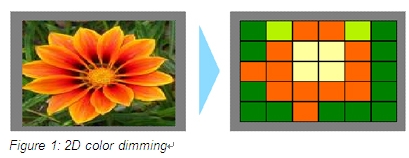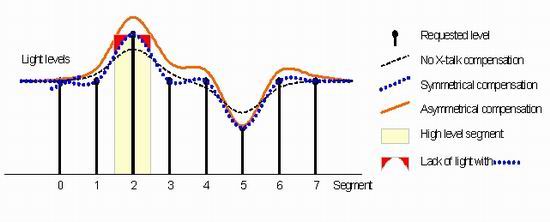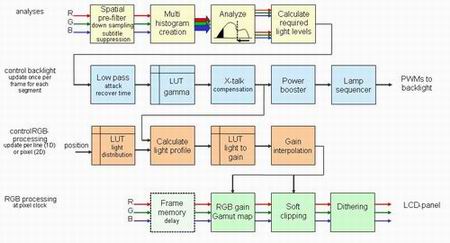Advanced backlighting technology using LED light sources and segmented control can create a dramatic viewing experience while reducing the power consumption of LCD TVs by up to 80%. This article refers to the address: http:// Solid backlights with LEDs have many unique advantages in LCD TV applications. LEDs offer better performance than cold cathode fluorescent tubes (CCFLs) and hot cathode fluorescent lamps (HCFLs), which currently dominate the market in large-area LCD backlights. This is not inherently high in their efficacy (lumen per watt)—it is the only source that is comparable to CCFL, but because LEDs can be more flexibly and efficiently dimmed to match the desired image brightness. Two-dimensional backlight dimming uses an addressable LED array to create a more vivid viewing experience, higher contrast, wider color gamut, and better color saturation. In the past few years, various dimming technologies for CCFL and HCFL backlights have been introduced. For example, in some cases, the entire backlight is adjusted to match the desired image brightness, a technique known as zero-dimensional dimming. When dimming is performed along an axis (for example, by controlling the intensity of an HCFL lamp or a group of parallel CCFL lamps), it is referred to as 1D dimming. Recently, with the cost reduction of LEDs and improved performance, LED backlighting has now become a more realistic proposal, opening up possibilities for new and more efficient backlight dimming technologies. In fact, LEDs can be conveniently arranged in a two-dimensional array and controlled separately, making it possible to perform two-dimensional dimming (horizontal and vertical), which is not possible with conventional CCFL or HCFL lamps. This allows the backlight circuit to generate more light locally in the area behind the bright areas of the displayed image, while producing darker light in dark areas where the image is not displayed. In fact, a 10 x 18 high efficiency white LED is sufficient to optimize the intensity of the backlight for typical image content, resulting in greater contrast and greatly reducing the average power consumption of the backlight circuit. This technique of locally controlling the backlight output based on image content can reduce the power consumption of providing backlighting for typical television image content by an average of approximately 50%. From white light to RGB backlight Two-dimensional LED backlights offer even greater advantages if three sets of color RGB LEDs are used to replace white LEDs. Compared with the conventional backlit LCD panel, by controlling the intensity of the three colors of red, green and blue among the three groups of LEDs, the color gamut that can be realized is greatly expanded. Therefore, a set of RGB LED backlights may create brighter, deeper, more saturated colors. Thus, intelligent saturation control can be applied to map the color space (sRGB) of video content to the backlight color space of the LED. Such mapping algorithms should preserve white, skin tones, and soft colors, but can extend saturated colors to vivid levels that only LEDs can produce. Figure 1: Two-dimensional color dimming By arranging the RGB LEDs in a two-dimensional array and controlling them separately on a color basis (two-dimensional dimming), you can reduce power consumption and increase color gamut and contrast. This is because each backlight segment only needs to produce the portion of the visible spectrum that the LCD pixels in front of them will emit, as shown in Figure 1. Conventional white light backlights use a fixed-color white point to create a visible spectrum, so most of its spectral energy is confined and consumed in the form of heat in the color filters of the LCD panel. Local control of the color of the backlight output based on image content, on average, can save approximately 80% of power consumption for typical TV content. Backlight dimming complexity Despite its benefits, backlight dimming is not straightforward. This is because it introduces two different ways of adjusting the brightness of the image. To achieve low-brightness images, such as night scenes, you can use LCD pixels to block more backlight output or alternately adjust the backlight. In terms of spatial and temporal contrast and color gamut, optimizing the performance of the front of the screen and the power consumption of the backlight can be achieved by increasing the pixel drive signal to compensate for the reduction in backlight brightness. Therefore, adaptive backlight dimming requires a large amount of image processing to be performed in the video stream to analyze the content of the image. The acquired information then needs to be intelligently combined with the features of the backlight to obtain an optimized backlight and pixel drive signal. The challenge is to have a very low spatial resolution backlight (typically 10 x 18 segments) and a very high definition LCD panel (1920 x 1080 pixels for HDTV). The situation becomes more complicated because of the optical coupling between adjacent backlight segments; in fact, each segment leaks some of its light to adjacent segments. Balance By performing statistical analysis on the values ​​of R, G, and B for each pixel of the image, respectively, the desired optimized backlight level can be determined to determine the appropriate drive level for the corresponding backlight segment. If all pixel levels are high, they will match the backlight at a regular backlight level. When the RGB pixel value is low, the backlight level is adjusted to minimize light leakage through the panel, and the RGB gain of the LCD pixels needs to be increased to maintain the desired image brightness. Contrast (especially for dark levels) will improve, but will blur out bright pixels. Therefore, adaptive backlighting algorithms need to find an optimal compromise. The red, green, and blue gains also need to be adjusted to compensate for the changing RGB blending light levels from the backlight in the color filters of the LCD panel. Interaction between segments of the backlight The interaction between the segments of the backlight due to optical coupling has a large impact on the performance of the entire image. This coupling limits effective spatial backlight modulation, so the achievable image quality improvement is highly dependent on the characteristics and construction of the backlight. Another important aspect of coupling compensation is the dynamic driving of the backlight LED at a nominal level, a process known as adaptive boosting. This can compensate for the lack of light in a certain segment caused by dimming of adjacent segments. Coupling compensation helps to reduce the difference between the predicted light level at the center of a segment and the desired light level. Therefore, the spatial modulation of the backlight curve is amplified. However, direct linear error compensation results in a lack of light at the boundaries of the bright segments. Asymmetric compensation can prevent this problem, as shown in Figure 2. Figure 2: Symmetric and asymmetric coupling compensation In places where the number of LEDs in the backlight is small, the opportunity to use backlight boosting technology is limited. This is because the number of LEDs is small and each LED must be driven to the maximum level to achieve the desired image brightness. However, as the number of LEDs in the backlight increases, backlight boosting techniques can be used to achieve greater results, not only compensating for coupling, but also increasing the sharpness of bright image content. As the number of LEDs increases, the backlight segment will be smaller, allowing the backlight brightness to be modulated over a larger range and providing a more space-time contrast. For typical image content, dimming and boosting techniques can reduce power consumption by more than 50% without introducing traces of visible images being manipulated. bright future Unfortunately, the higher cost of current high efficiency LEDs limits the number of backlight LEDs to a few hundred compared to conventional CCFL or HCFL lamps. However, as LED backlighting technology matures, these cost differences may shrink. LED backlights have become popular in mobile devices and are emerging in notebook computers due to their higher efficiency. For TVs, it may be introduced first in screens of 50 inches or more, and as production costs decrease, it will gradually be promoted to smaller TV sets. Figure 3: Adaptive dimming block diagram (click to enlarge the picture) In order to facilitate the introduction and encouragement of LED-based adaptive backlight control technology, NXP Semiconductors has implemented all the algorithms required for 2D white LED dimming on the PNX5100 LCD TV platform, as well as 2D RGB LED dimming and coloring. Domain mapping function. The PNX5100 is located at the back end of the video tube. It controls the up-conversion to 120Hz motion compensation and a two-dimensional backlight driver using an on-chip hardware pixel-based accelerator, as shown in Figure 3. Its software-driven backlight control is highly flexible and can be adjusted to the specific customer's requirements and display panel. Litecoin is an online currency based on peer-to-peer technology and is an open source software project under the MIT/X11 license. It can help users make instant payments to anyone in the world [2]. Litecoin was designed and programmed by a programmer (Li Qiwei) who used to work at Google, and launched on January 9, 2011. Litecoin is an improved digital currency inspired by Bitcoin. The technical principle of Litecoin is the same as that of Bitcoin. It also adopts a decentralized architecture, without any central authority control, and the issuance of new coins and the transfer of transactions and payments are based on open source encryption algorithms, etc. These are all imitated the design principle of Bitcoin. However, Litecoin tries its best to improve the shortcomings that Bitcoin has shown before, such as too slow transaction confirmation, small total cap, the emergence of large mining pools caused by proof-of-work mechanism and so on, SHA256 algorithm [1].
Litecoin, which aims to improve Bitcoin, has three significant differences. First, the Litecoin network can process a block every 2.5 minutes instead of 10, thus providing faster transaction confirmation. Second, the Litecoin network is expected to produce 84 million litecoins, four times the amount of money issued on the Bitcoin network. Each litecoin is divided into 100 million smaller units, defined by eight decimal places.
Litecoin Mining Machine:Bitmain Antminer L7,Goldshell Mini-DOGE Pro,Goldshell LT Lite,Innosilicon A4+ LTCMaster,Goldshell LT5, Litecoin Mining Machine,L3 Miner,Antminer L7,Ltc Mining Machine,Scrypt Shenzhen YLHM Technology Co., Ltd. , https://www.ylhm-tech.com


Bitmain Antminer L3+ (504Mh),Bitmain Antminer L3+ (600Mh),etc.
June 14, 2024